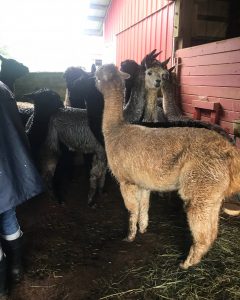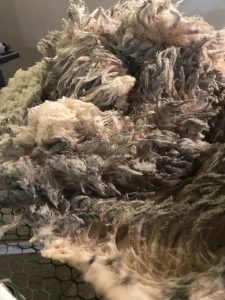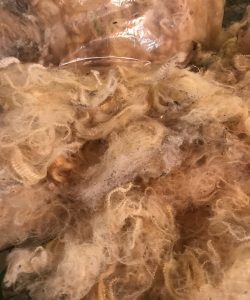For my first day interning at Olympic Yarn & Fiber, I jumped right in by helping to trim the toe nails of Lynn’s female alpacas. I learned that it is important to trim their nails because if they grow too long, they can curve under the alpaca’s foot and cause issues with joints and walking – this is particularly true for alpacas living in pastures with soft grounds, as opposed to the rugged terrain that they are native to.

Since I don’t have any experience handling alpaca, a lot of my work was observational. I made to sure take note of how Lynn interacted with her animals and how they responded to her movement. I noticed very quickly that the herd as a whole were very interested in the well being of each individual alpaca. We opted to keep the herd together as a way to keep them calmer while trimming. In order to catch each individual alpaca, we used a harness hold to keep them in place. This is done by grabbing their head and placing one hand on the back of the skull and one underneath the jaw. This way, the animal is unable to swing its head around and potentially harm itself or others. To trim the toenails, we gently lifted each of the animals’ legs and trimmed the nails to be equal with the padding on their feet. We got 6 of 12 done on Sunday, but decided to wait to do the other half so as to not make the herd too stressed. After we finished, we fed them and allowed them all to go back into the pasture.

For the second part of the day, I helped Lynn to sort through some merino fleeces that she purchased from a woman on Vashon Island. I learned that merino sheep are incredibly hard to find in this area due to their breed’s susceptibility to hoof and skin rot in wet weather, so the flock from which Lynn got her fleece is very special. The fleece was from two year growth, so the fiber staple was much longer than usual. However, this also meant that there was a whole year more opportunity for mud and twigs to get caught in the fleece, so we had our work cut out for us. In order to sort the fleece, we pulled out as much debris as possible and pulled it apart tuft by tuft in order to test how well it had been skirted and its overall quality. This also allows for dirt to leave the fiber more easily during the scouring process.

Overall, it was an incredibly successful first day and I feel like I learned quite a lot for the amount of time I spent there. I’ll be going back next Sunday to learn more about the mill machinery and to help with animal feeding.